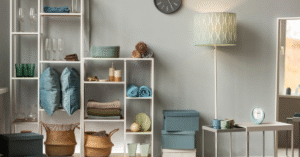How to Organize Your Home Like a Pro

A well-organized home creates a stress-free environment. Simple steps help you declutter and arrange spaces efficiently. Learning how to organize your home improves daily life.
1. Start with One Room at a Time
Organizing the entire home at once can be overwhelming. Focusing on one room makes the process manageable. Small steps lead to a well-organized space.
Choose a room that needs the most attention. Decluttering one area before moving to the next ensures progress. Breaking tasks into sections prevents frustration.
Setting a specific time for each room helps maintain focus. A clear plan speeds up the organizing process. Tackling one area at a time keeps motivation high.
2. Declutter and Remove Unnecessary Items
Clutter takes up space and creates stress. Removing unnecessary items makes organizing easier. A clutter-free home feels more spacious and inviting.
Sorting items into categories helps. Keep, donate, or discard decisions simplify decluttering. Letting go of unused things creates a more functional space.
Decluttering regularly prevents buildup. A routine helps maintain a clean environment. Keeping only essential items improves organization.
3. Use Smart Storage Solutions
Storage solutions maximize space efficiency. Well-placed storage keeps items accessible. Using the right organizers makes a big difference.
Baskets, bins, and shelves help store items neatly. Labeling containers simplifies finding things quickly. Hidden storage saves space and reduces clutter.
Multipurpose furniture provides extra storage. Beds with drawers and ottomans with compartments keep rooms tidy. Smart storage maintains a well-organized home.
4. Create a Designated Space for Everything
Assigning a place for each item prevents mess. Knowing where things belong reduces daily clutter. A structured home stays neat effortlessly.
Grouping similar items together enhances organization. Keeping everyday essentials in accessible spots saves time. Clear labeling improves efficiency.
Returning items to their designated places maintains order. Consistent placement prevents misplaced objects. An organized system makes tidying up easier.
5. Maintain a Daily Cleaning Routine
Small daily habits prevent overwhelming messes. Spending a few minutes tidying up each day keeps the home organized. Consistency makes a significant impact.
Wiping surfaces regularly removes dust and dirt. Quick cleanups prevent deep cleaning sessions. A clean space promotes a refreshing atmosphere.
Creating a checklist helps track cleaning tasks. Breaking chores into smaller steps ensures they get done. A daily routine simplifies home maintenance.
6. Optimize Closet and Wardrobe Space
Closets often become cluttered quickly. Organizing clothes efficiently saves space. A well-arranged wardrobe makes getting ready easier.
Using vertical storage maximizes closet capacity. Hanging organizers, dividers, and foldable bins keep clothes neat. Categorizing by season streamlines selection.
Decluttering clothes regularly creates more space. Donating unused items keeps the closet functional. Organizing by color or style improves accessibility.
7. Use Drawer Organizers for Small Items
Drawers often become messy with small items. Using organizers keeps them neat. Structured storage simplifies finding things.
Dividers help separate different items. Small containers prevent clutter buildup. Categorizing drawers improves accessibility.
Tidying up drawers monthly prevents messes. Removing unnecessary items frees up space. A well-organized drawer system enhances efficiency.
8. Utilize Wall Space for Storage and Décor
Walls provide additional storage opportunities. Shelves and hooks help maximize vertical space. Smart wall use enhances home organization.
Floating shelves keep books and decorative items arranged. Wall-mounted racks store kitchen essentials. Hanging organizers save counter space.
Using pegboards in workspaces increases functionality. Command hooks provide easy storage solutions. Efficient wall use improves organization and aesthetics.
9. Keep Frequently Used Items Accessible
Placing daily essentials within reach improves efficiency. Easily accessible storage prevents unnecessary searching. Organizing based on usage simplifies routines.
Kitchen utensils should be stored near cooking areas. Everyday skincare products should be placed on open shelves. Keeping essentials in reachable spots saves time.
Arranging items based on priority enhances workflow. Less-used items can be stored in upper cabinets. Proper placement ensures a smooth daily routine.
10. Refresh and Reorganize Regularly
Organization is an ongoing process. Refreshing spaces periodically maintains order. Small updates keep the home looking neat.
Reevaluating storage solutions helps improve efficiency. Adjusting arrangements based on lifestyle changes optimizes space. Regular reorganizing prevents clutter buildup.
Seasonal cleanouts keep things manageable. Rotating decorations and wardrobe essentials maintains freshness. Regular upkeep ensures a consistently organized home.
Conclusion
Learning how to organize your home creates a stress-free environment. Decluttering, smart storage, and regular maintenance keep spaces functional. A well-organized home enhances daily living.








